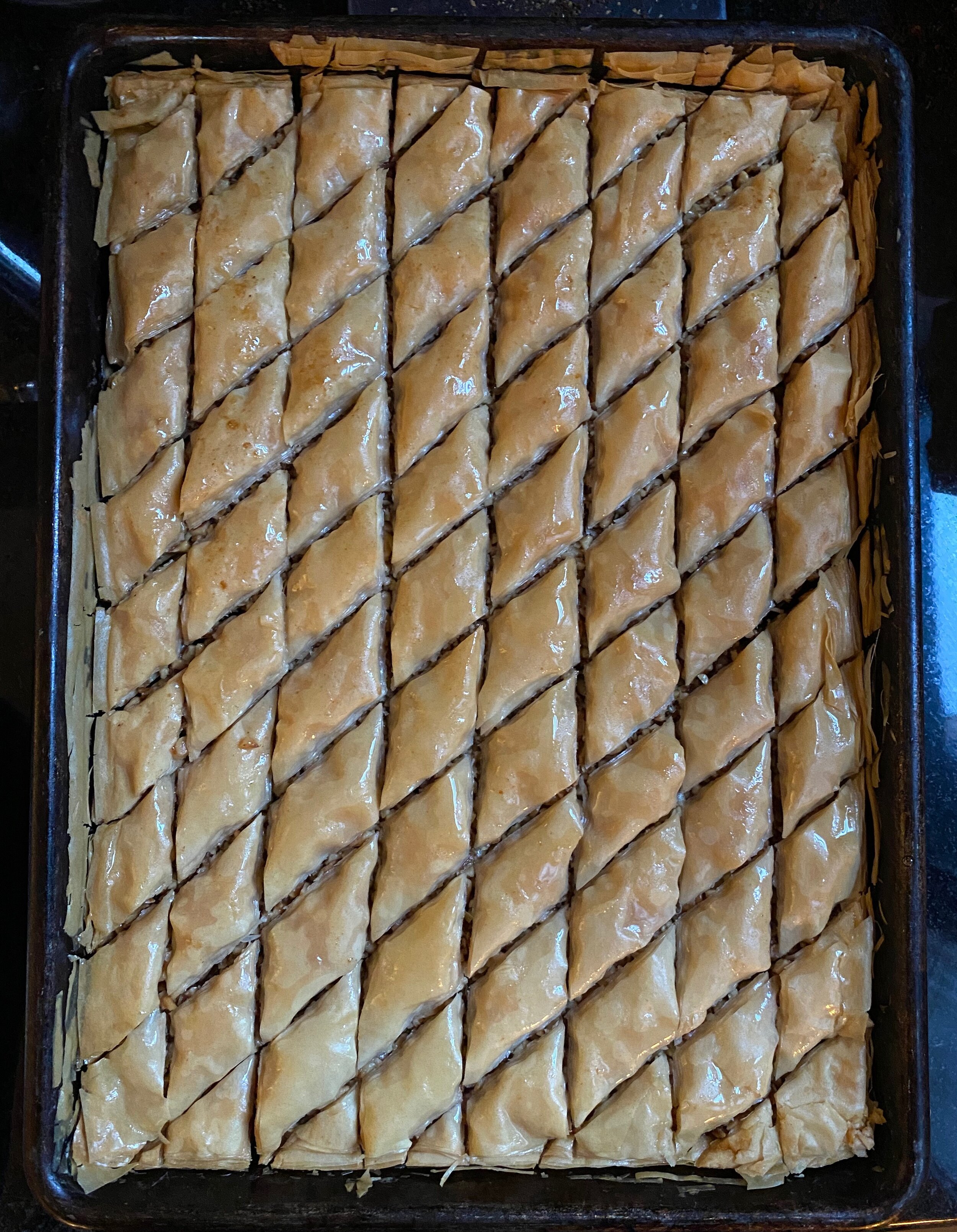Baklava
Baklava
Makes about 30 (1 1/2 inch) pieces
This baklava comes from Lucy Simon, whose Iraqi grandmother made this recipe for her as a child. In fact, Daisy Iny, who wrote“The Best of Baghdad Cooking with Treats from Teheran” got this recipe from Lucy’s great aunt. This dessert is a total texture fantasy. It’s lighter than other baklavas and best eaten warm from the oven, though, trust me, it is delicious at room temperature, too. It’s impossible to eat just one.
Ingredients:
2 cups walnuts, finely chopped
1 cup, plus 2 tablespoons, granulated sugar
1 teaspoon ground cardamom
1/4 teaspoon fine salt
1 1/2 cups (12 tablespoons) unsalted butter, cut into pieces
1 small roll (about 8 ounces) phyllo dough, thawed overnight in the fridge
1 tablespoon rose water
1 teaspoon freshly squeezed lemon juice
Steps:
1. Heat the oven to 350°F.
2. Place the finely chopped walnuts in a medium mixing bowl. Add 2 tablespoons sugar, ground cardamom, and salt. Stir to combine and set aside.
3. In a heatproof bowl, melt all of the butter in the microwave, for about 60 seconds; set aside.
4. Open the phyllo package and unroll it gently. Place a damp towel over the pastry. (When exposed to air, the phyllo will become dry and brittle quickly, so the damp covering helps keep it soft.)
5. Using a pastry brush, paint a 9-by-13-inch baking sheet pan or a metal 9-by-13-inch baking pan with a thin layer of melted butter. Place one sheet of phyllo pastry over the melted butter. You can cut the the pastry to fit the shape of the pan or use a patchwork of small pieces to complete the layer (the phyllo does crumble so patch-working it together works fine!) On the first few layers, cut the phyllo to 1/4 inch wider than the pan on all sides, so that it rises up the sides slightly. Repeat this process of painting a thin layer of butter over the phyllo pastry and covering it with another layer of dough until you have used half of the pastry.
6. Once you have used half of the pastry dough, use a spoon or clean hands to sprinkle all of the nut mixture in an even layer over your pastry layers. Repeat the layering with the rest of the pastry and butter.
7. Once you have used all your pastry, brush the top layer with extra butter. This will help protect it from drying out in the oven.
8. Using a paring knife, cut your pastry into small diamonds by cutting a diagonal line from one corner of the pan to the other. Be careful not to tear the pastry. Starting on the left, move your knife 1 inch to the right of the first line and cut another line parallel to it. Moving toward the right side of the pan, repeat this until your line is 1 inch from the corner. Flip the pan around 180 degrees and repeat the parallel diagonal cuts on the other side. Next, turn the pan 90 degrees and cut straight, lengthwise lines, 1 inch apart from each other. This will expose the diamonds.
9. Bake your baklava until golden brown and crisp, for about 35 minutes, rotating the pan half way through.
10. While your baklava is in the oven, prepare the syrup. Add 1 cup sugar and 3/4 cup water to a medium saucepan over medium heat. Bring to a boil, then reduce to a simmer. Add the rosewater and 1 teaspoon lemon juice and continue to simmer for 3 minutes. You are looking for a silky, clear syrup with no coloring. Set aside to cool.
11. Take your baklava out of the oven. Using a spoon, pour the syrup over the baklava making sure to saturate it evenly. Let cool and enjoy! Recipe by Lucy Simon, adapted from “The Best of Baghdad Cooking with Treats from Teheran” by Daisy Iny.

